Water treatment
Anaerobic expanded granular sludge bed technology
Technical introduction
The development of anaerobic reactor has gone through three times.The third generation reactor represented by EGSB not only separates the solid retention time and hydraulic retention time,but also makes the solid and liquid phases fully contact,so that it can not only maintain a large amount of anaerobic activated sludge,but also make the wastewater and sludge fully contact and mix,so as to achieve real efficiency.
EGSB is a fine and high structure reactor,which can treat industrial wastewater from different industries.The wastewater is mixed with part of anaerobic effluent in the conditioning tank and pumped into the anaerobic reactor,so that the hydraulic load entering the reactor will not be affected by the change of raw water volume entering the sewage treatment plant and will remain constant.As the circulating wastewater contains a large amount of alkalinity,it can reduce the consumption of alkali.
The conditioned mixed wastewater is pumped into the bottom of the reactor through a specially designed inlet water distribution system.The wastewater then flows through the granular sludge bed and undergoes anaerobic reaction.There is a patented three-phase separator at the top of the reactor,which can better separate the treated wastewater,biogas and sludge even under the condition of high hydraulic load impact.A large amount of anaerobic effluent will be returned to the conditioning tank to dilute the raw water,which can dilute part of the toxic substances in the wastewater through reflux,reduce their concentration and degrade them.
Because a large amount of biological sludge is stored in the reactor for a long time and well mixed with influent,EGSB reactor can be applied in low temperature environment.The reactor operates in a closed environment without oxygen,which can avoid(oxidation)corrosion of the reactor.In addition,the reactor is a pressurized system,and the generated biogas can be transferred to the following units for treatment or utilization without using compressors and biogas buffer tanks.
Technical features
High volume load,less land occupation,and degradation of toxic substances
Strong SS resistance and free from corrosion
Rapid start-up and low sludge production
The biogas produced can be reused with strong resistance to hydraulic load impact
Low consumption of nutrients,selective construction methods and materials
Low power consumption and maintenance cost
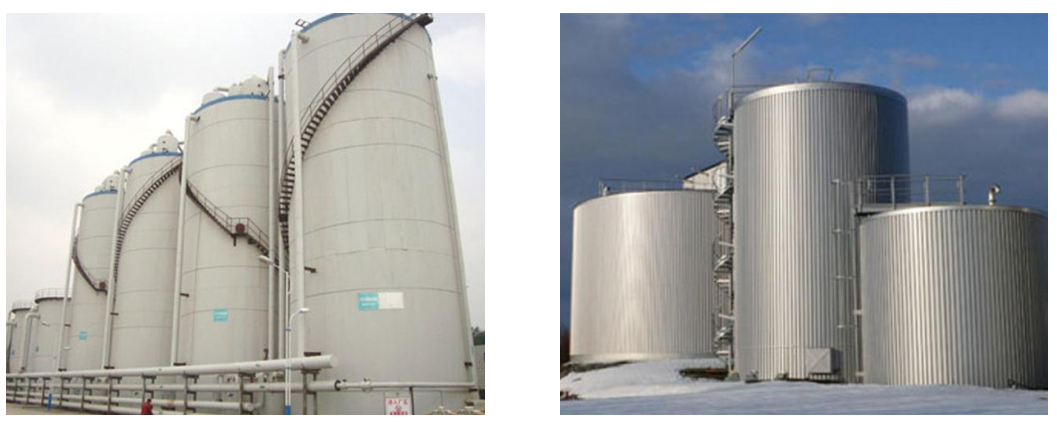
Carrier flow bed biofilm technology
Technical introduction
Moving bed biofilm reactor(MBBR)is a biological fluidized bed technology based on special structured fillers.This technology organically combines the biofilm process and activated sludge process in the same biological treatment unit to improve the treatment capacity and treatment effect of the reaction tank and enhance the impact resistance of the system.At present,many wastewater treatment plants using carrier fluidized bed technology have been operating in more than 20 countries around the world,including municipal,chemical,oil refining,pharmaceutical,papermaking and food.
Technical features
The attached microorganisms can reach a very high biomass.The total biological concentration in the reaction tank is 2~4 times that of the suspended growth activated sludge process.Therefore,the pollutant degradation efficiency is doubled.
The microorganism is attached to the inner surface of the carrier filler with special structure,so the microorganism is fully protected to prevent friction loss,and at the same time,good mass transfer effect can be obtained.The biomass in the system is stable,the activity is higher,and the impact resistance is stronger.
The microbial sludge on the surface of the carrier has a long age(20~40 days),which is very conducive to the reproduction of slow-growing nitrifying bacteria and other autotrophic microorganisms,and the system has strong nitrification and ammonia removal capacity.At the same time,the bacteria in the reaction tank are more abundant,the removal of refractory pollutants is significantly enhanced,and the effluent quality is significantly improved.
MBBR mobile bed technology has flexible application mode,and its application in new sewage treatment system can significantly reduce the floor area;When applied to the upgrading of the existing system,the project implementation is simple and easy,and the processing capacity and processing effect can be greatly improved.
Membrane bioreactor technology
Technical introduction
MBR is a new wastewater treatment system which combines membrane separation technology with biological treatment technology.The end secondary sedimentation tank of traditional biological treatment technology is replaced by membrane modules,and the membrane separation equipment immersed in the aerobic biological tank is used to intercept the activated sludge and macromolecular organics in the tank.
Process principle
MBR process organically combines the membrane separation technology in the separation project with the traditional wastewater biological treatment technology,which not only saves the construction of secondary sedimentation tank,but also greatly improves the solid-liquid separation efficiency,and improves the biochemical reaction rate due to the increase of activated sludge concentration in the aeration tank and the emergence of specific bacteria(especially dominant bacteria)in the sludge.At the same time,by reducing the f/m ratio to reduce the amount of excess sludge(even zero),many outstanding problems existing in the traditional activated sludge process have been basically solved.

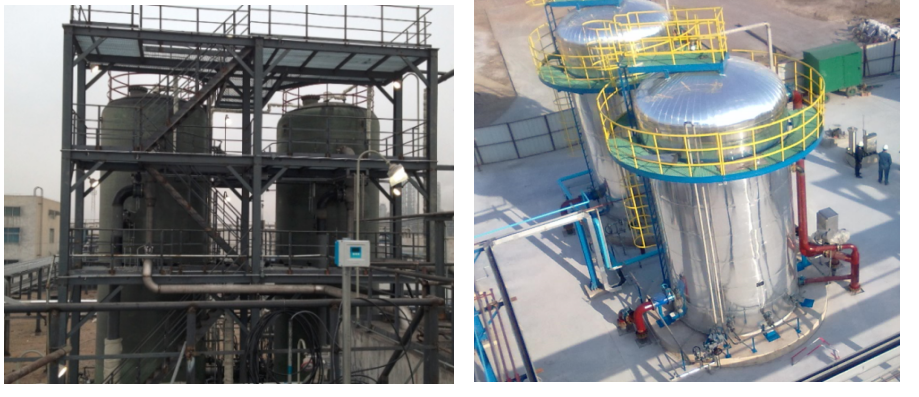
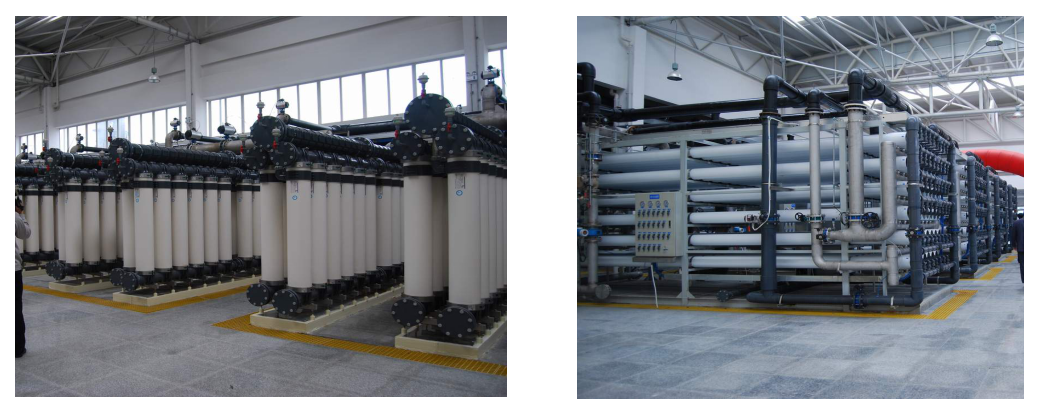

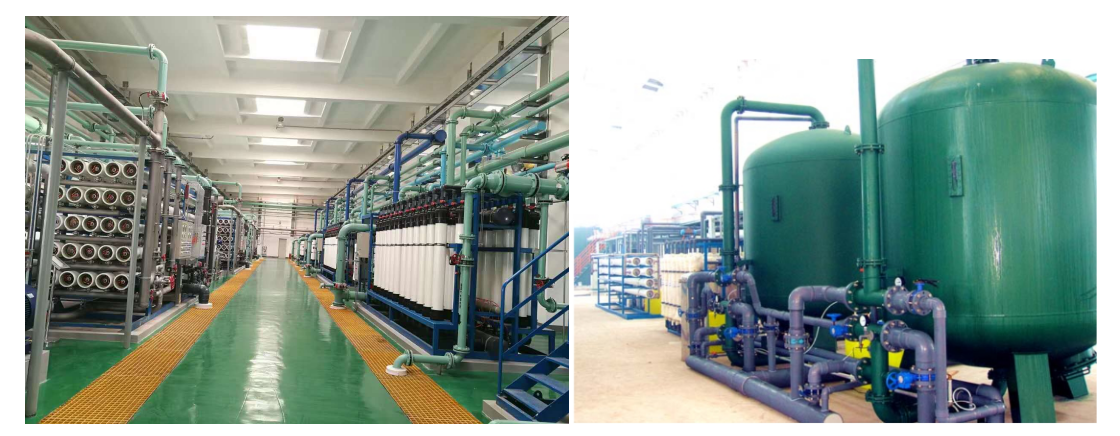
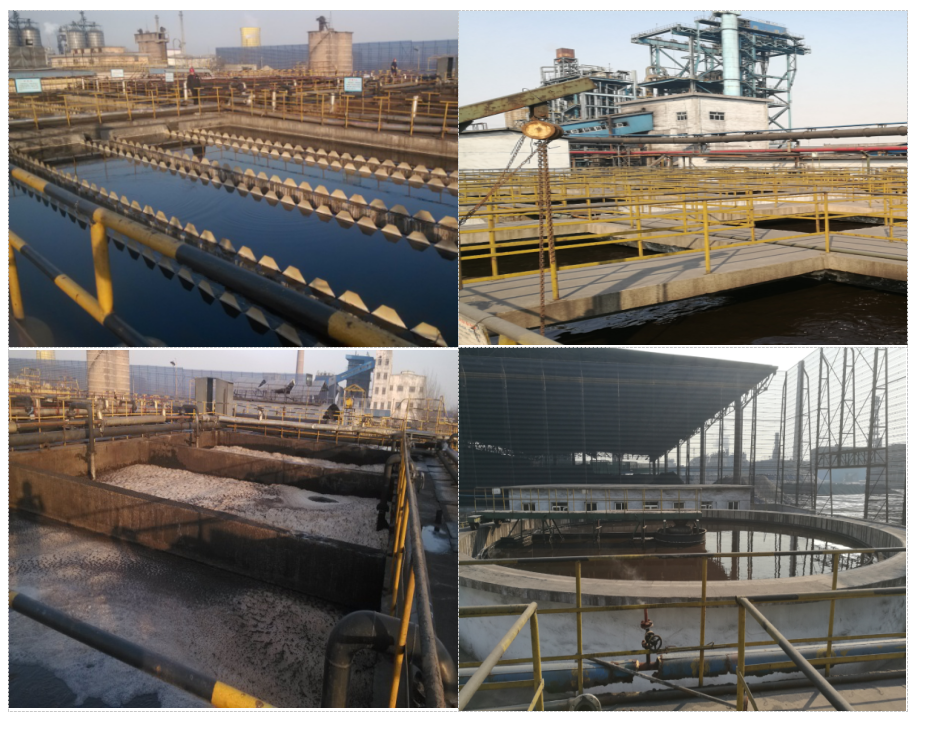
Zero discharge treatment of desulfurization wastewater
Project overview
In order to maintain the material balance of the slurry circulating system of the desulfurization unit,prevent the chlorine concentration in the soluble part of the flue gas from exceeding the specified value and ensure the quality of gypsum,a certain amount of waste water must be discharged from the system.The waste water mainly comes from the gypsum dehydration and cleaning system.The impurities contained in the wastewater mainly include suspended solids,supersaturated sulfites,sulfates and heavy metals,many of which are the first class pollutants required to be strictly controlled in the national environmental protection standards.
Wastewater treatment and zero discharge technology process route
The conventional treatment process of desulfurization wastewater in China mainly adopts physicochemical method to separate heavy metals and other precipitable salts by chemical and mechanical methods.This method has mature process,simple process and low cost.In order to effectively recover and utilize desulfurization wastewater,advanced treatment,reuse and zero discharge technologies for desulfurization wastewater have been developed at home and abroad on the basis of conventional treatment processes.At present,the commonly used advanced treatment technologies for desulfurization wastewater include membrane concentration method(UF,NF,RO,DTRO,DM,forward osmosis and electrodialysis),evaporation concentration method(MVR,MED)and crystallization technology.
Zero discharge treatment of high salinity wastewater from coal chemical industry
Project overview
The high salinity wastewater of coal chemical industry is usually the reclaimed water formed by mixing the biochemical production wastewater with the circulating water discharge wastewater and RO concentrated water of demineralized water station.The wastewater with high COD,high calcium,magnesium and high soluble silicon is produced after ro further recovery and concentration.The ratio of sulfate radical to chloride ion changes with the new fresh water source and production process.In order to prevent scaling in the concentration crystallization section during zero discharge treatment,it is usually necessary to add chemicals to soften and remove calcium,magnesium and dissolved silicon;In order to prevent the organic matter from polluting the crystalline salt after being concentrated,resulting in unqualified purity,it is usually necessary to consider advanced oxidation to remove COD;It is required to discharge zero discharge liquid and dissolve salt crystallization to produce refined sodium chloride that can be used in chlor alkali industry and mirabilite or sodium sulphate(i.e.sodium sulphate)that meets industrial salt standards.
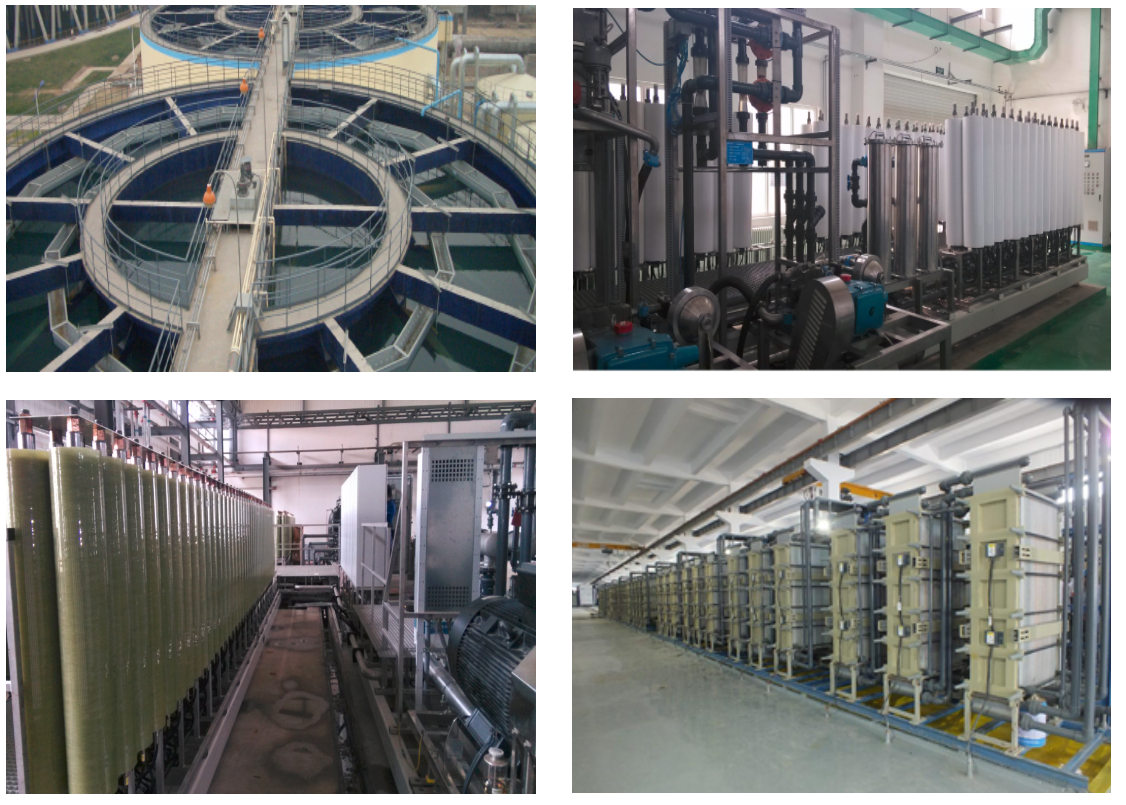
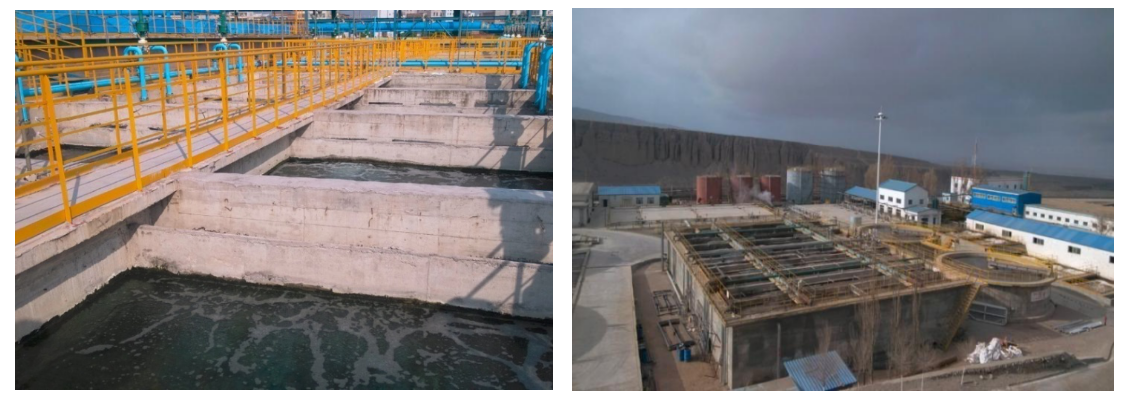
Technical introduction
Moving bed biofilm reactor(MBBR)is a biological fluidized bed technology based on special structured fillers.This technology organically combines the biofilm process and activated sludge process in the same biological treatment unit to improve the treatment capacity and treatment effect of the reaction tank and enhance the impact resistance of the system.At present,many wastewater treatment plants using carrier fluidized bed technology have been operating in more than 20 countries around the world,including municipal,chemical,oil refining,pharmaceutical,papermaking and food.
Technical features
The attached microorganisms can reach a very high biomass.The total biological concentration in the reaction tank is 2~4 times that of the suspended growth activated sludge process.Therefore,the pollutant degradation efficiency is doubled.
The microorganism is attached to the inner surface of the carrier filler with special structure,so the microorganism is fully protected to prevent friction loss,and at the same time,good mass transfer effect can be obtained.The biomass in the system is stable,the activity is higher,and the impact resistance is stronger.
The microbial sludge on the surface of the carrier has a long age(20~40 days),which is very conducive to the reproduction of slow-growing nitrifying bacteria and other autotrophic microorganisms,and the system has strong nitrification and ammonia removal capacity.At the same time,the bacteria in the reaction tank are more abundant,the removal of refractory pollutants is significantly enhanced,and the effluent quality is significantly improved.
MBBR mobile bed technology has flexible application mode,and its application in new sewage treatment system can significantly reduce the floor area;When applied to the upgrading of the existing system,the project implementation is simple and easy,and the processing capacity and processing effect can be greatly improved.
Membrane bioreactor technology
Technical introduction
MBR is a new wastewater treatment system which combines membrane separation technology with biological treatment technology.The end secondary sedimentation tank of traditional biological treatment technology is replaced by membrane modules,and the membrane separation equipment immersed in the aerobic biological tank is used to intercept the activated sludge and macromolecular organics in the tank.
Process principle
MBR process organically combines the membrane separation technology in the separation project with the traditional wastewater biological treatment technology,which not only saves the construction of secondary sedimentation tank,but also greatly improves the solid-liquid separation efficiency,and improves the biochemical reaction rate due to the increase of activated sludge concentration in the aeration tank and the emergence of specific bacteria(especially dominant bacteria)in the sludge.At the same time,by reducing the f/m ratio to reduce the amount of excess sludge(even zero),many outstanding problems existing in the traditional activated sludge process have been basically solved.

Advanced catalytic oxidation technology
Technical introduction
Advanced catalytic oxidation technology is a recognized advanced technology for the treatment of high concentration and refractory organic wastewater.The characteristic of this technology is that the oxidant can achieve the purpose of heterogeneous catalytic oxidation under the action of the newly developed high oxidation activity and high stability catalyst,and effectively degrade the refractory pollutants in wastewater.
The three-phase catalytic oxidation technology,a new high-efficiency catalytic oxidation technology independently developed by our company,uses oxidants such as ozone or chlorine dioxide to effectively generate and increase free radicals in the reaction system through the catalysis of metal ion catalyst with special formula carrier,so as to produce a comprehensive and intense oxidation reaction to remove or decompose and transform COD components that are highly difficult to degrade.The reaction does not need to be carried out under high temperature and high pressure.Under normal conditions,the reaction requirements can be met and high oxidation treatment efficiency can be obtained.
Technical introduction
Advanced catalytic oxidation technology is a recognized advanced technology for the treatment of high concentration and refractory organic wastewater.The characteristic of this technology is that the oxidant can achieve the purpose of heterogeneous catalytic oxidation under the action of the newly developed high oxidation activity and high stability catalyst,and effectively degrade the refractory pollutants in wastewater.
The three-phase catalytic oxidation technology,a new high-efficiency catalytic oxidation technology independently developed by our company,uses oxidants such as ozone or chlorine dioxide to effectively generate and increase free radicals in the reaction system through the catalysis of metal ion catalyst with special formula carrier,so as to produce a comprehensive and intense oxidation reaction to remove or decompose and transform COD components that are highly difficult to degrade.The reaction does not need to be carried out under high temperature and high pressure.Under normal conditions,the reaction requirements can be met and high oxidation treatment efficiency can be obtained.

Ultrafiltration and reverse osmosis technology
Technical introduction
The production of reclaimed water,seawater desalination and ultra pure water depends on membrane filtration technology.Our company can select the combined process of UF(ultra filtration)and RO(reverse osmosis)to produce high-quality reclaimed water according to the water quality requirements of raw water and reclaimed water.
The high-quality reclaimed water obtained by ultrafiltration to remove the residual turbidity,colloidal substances,bacterial viruses and some TOC in the raw water,and then by reverse osmosis to remove the dissolved solids can be used for boiler feed water.
Technical advantages
The quality of ultrafiltration effluent is excellent,so higher flux can be used in the design of reverse osmosis system,thus reducing the investment cost of reverse osmosis system.
Ultrafiltration has a high removal rate of suspended solids,microorganisms and body removal,which reduces the cleaning frequency of the reverse osmosis system,reduces the operation cost,and extends the service life of the reverse osmosis membrane.
The whole system has a high degree of automation,intelligent physical cleaning and chemical cleaning,and completely unattended.
Compared with traditional membrane pretreatment,the water recovery rate is higher,the energy consumption is lower,the performance recovery after chemical cleaning is better,and the floor area is less.
Technical introduction
The production of reclaimed water,seawater desalination and ultra pure water depends on membrane filtration technology.Our company can select the combined process of UF(ultra filtration)and RO(reverse osmosis)to produce high-quality reclaimed water according to the water quality requirements of raw water and reclaimed water.
The high-quality reclaimed water obtained by ultrafiltration to remove the residual turbidity,colloidal substances,bacterial viruses and some TOC in the raw water,and then by reverse osmosis to remove the dissolved solids can be used for boiler feed water.
Technical advantages
The quality of ultrafiltration effluent is excellent,so higher flux can be used in the design of reverse osmosis system,thus reducing the investment cost of reverse osmosis system.
Ultrafiltration has a high removal rate of suspended solids,microorganisms and body removal,which reduces the cleaning frequency of the reverse osmosis system,reduces the operation cost,and extends the service life of the reverse osmosis membrane.
The whole system has a high degree of automation,intelligent physical cleaning and chemical cleaning,and completely unattended.
Compared with traditional membrane pretreatment,the water recovery rate is higher,the energy consumption is lower,the performance recovery after chemical cleaning is better,and the floor area is less.

Zero discharge wastewater treatment technology
Project overview
In order to promote the coordinated development of industrial economy,water resources and environment,the outline of China's water saving technology policy issued in 2005 first proposed to develop the technology of reuse of discharged wastewater and"zero discharge".The 11th Five Year Plan for national environmental protection clearly requires the promotion of wastewater recycling in key industries such as iron and steel,electric power,chemical industry and coal to strive to achieve less or zero wastewater discharge.In recent years,some places have successively promulgated strict wastewater discharge standards.The Yellow River,Huaihe River and other water bodies are seriously polluted and sensitive basins,regions and provinces do not even allow industrial enterprises to discharge wastewater into surface water bodies.Therefore,seeking a wastewater treatment process with better treatment effect,stronger process stability and lower operation cost to achieve the goal of"zero wastewater discharge"has become the self demand and external requirement for the development of the above industries.
technological process
The evaporation cost is much higher than the membrane concentration cost.The zero emission technology improves the recovery rate of the membrane concentration unit as much as possible and reduces the processing capacity of the evaporation and crystallization system.At present,membrane concentration technology mainly includes the following modes:
(1)Ordinary roll type reverse osmosis membrane is adopted;(2)Avoiding the physical conditions of membrane scaling,the large channel disc membrane process is adopted,mainly including disc tube reverse osmosis(DTRO)and ultrafrequency vibrating membrane(DM);(3)Forward osmosis technology;(4)Electrodialysis(ED).
The principle of the mechanical vapor recompression(MVR)evaporator is to use the high-energy steam compressor to compress the secondary steam generated by evaporation,convert electric energy into heat energy,increase the enthalpy of the secondary steam,and drive the secondary steam with increased heat energy into the evaporation chamber for heating,so as to recycle the existing heat energy of the secondary steam,so that the purpose of evaporation and concentration can be realized through the self circulation of the evaporator without external fresh steam.The system temperature,pressure and motor speed are controlled through PLC,industrial computer(FA)and configuration to maintain the evaporation balance of the system.Theoretically,MVR evaporators save more than 80%of energy,more than 90%of condensate and more than 50%of floor space than traditional evaporators.
Multi effect evaporation(MED)multi effect evaporation is to make the heated brine evaporate in multiple evaporators in series.The steam evaporated from the previous evaporator is used as the heat source of the next evaporator and condensed into fresh water.Multi effect evaporation technology has been applied earlier in China,and the technology is relatively mature.
Project overview
In order to promote the coordinated development of industrial economy,water resources and environment,the outline of China's water saving technology policy issued in 2005 first proposed to develop the technology of reuse of discharged wastewater and"zero discharge".The 11th Five Year Plan for national environmental protection clearly requires the promotion of wastewater recycling in key industries such as iron and steel,electric power,chemical industry and coal to strive to achieve less or zero wastewater discharge.In recent years,some places have successively promulgated strict wastewater discharge standards.The Yellow River,Huaihe River and other water bodies are seriously polluted and sensitive basins,regions and provinces do not even allow industrial enterprises to discharge wastewater into surface water bodies.Therefore,seeking a wastewater treatment process with better treatment effect,stronger process stability and lower operation cost to achieve the goal of"zero wastewater discharge"has become the self demand and external requirement for the development of the above industries.
technological process
The evaporation cost is much higher than the membrane concentration cost.The zero emission technology improves the recovery rate of the membrane concentration unit as much as possible and reduces the processing capacity of the evaporation and crystallization system.At present,membrane concentration technology mainly includes the following modes:
(1)Ordinary roll type reverse osmosis membrane is adopted;(2)Avoiding the physical conditions of membrane scaling,the large channel disc membrane process is adopted,mainly including disc tube reverse osmosis(DTRO)and ultrafrequency vibrating membrane(DM);(3)Forward osmosis technology;(4)Electrodialysis(ED).
The principle of the mechanical vapor recompression(MVR)evaporator is to use the high-energy steam compressor to compress the secondary steam generated by evaporation,convert electric energy into heat energy,increase the enthalpy of the secondary steam,and drive the secondary steam with increased heat energy into the evaporation chamber for heating,so as to recycle the existing heat energy of the secondary steam,so that the purpose of evaporation and concentration can be realized through the self circulation of the evaporator without external fresh steam.The system temperature,pressure and motor speed are controlled through PLC,industrial computer(FA)and configuration to maintain the evaporation balance of the system.Theoretically,MVR evaporators save more than 80%of energy,more than 90%of condensate and more than 50%of floor space than traditional evaporators.
Multi effect evaporation(MED)multi effect evaporation is to make the heated brine evaporate in multiple evaporators in series.The steam evaporated from the previous evaporator is used as the heat source of the next evaporator and condensed into fresh water.Multi effect evaporation technology has been applied earlier in China,and the technology is relatively mature.

Electroplating wastewater treatment and recycling
Project overview
Wastewater comes from various electroplating production lines,and the quality of wastewater discharged varies according to the plating type and plating method.The water quality of electroplating wastewater is complex and its components are difficult to control.It contains heavy metal ions such as chromium,cadmium,nickel,copper,zinc,gold,silver and cyanide.Some of them are highly toxic substances that cause cancer,teratogens and mutations.
Process route of wastewater treatment technology
Electroplating wastewater is required to be discharged by quality and collected by classification.The quality of wastewater treated by wastewater treatment technology is stable and better than the pollutant indicators in the discharge standard for electroplating pollutants gb21900-2008.This technology is applicable to new or expanded electroplating wastewater treatment projects.
Process route of resource treatment technology
After the treatment of heavy metal(electroplating)wastewater is stable and up to standard,the wastewater reuse treatment technology is applied to increase the reuse rate of the traditional process from 60%to more than 75%.The conductivity of the effluent quality of the system is far better than the municipal tap water quality standard.The system water can be directly reused in the electroplating production line,and the remaining concentrated water can be discharged after being treated to meet the pollutant indicators in the discharge standard for electroplating pollutants gb21900-2008.
Technical features
Compared with the traditional electroplating wastewater treatment,this technology saves 50%of the floor area,and the removal rates of various heavy metal ions are greater than 98%.
Using this technology to treat heavy metal wastewater,all indicators of the treated effluent are better than the discharge standard limit.The conductivity of reused treated effluent is stable<150μS/cm,the index is far better than the municipal tap water quality standard.
With this technology and equipment,the power consumption is about 30%less than that of traditional equipment on the premise that the treatment meets the standard.
All process sections can use monitoring equipment to realize remote control and unattended,so as to save labor costs to the greatest extent for the enterprise.
The technology can control the water production cost below the water price of industrial tap water,and save costs for enterprises while protecting the environment.
The application of this technology can not only save costs for enterprises,but also reduce emissions for enterprises,comply with the national environmental protection trend,and create a good reputation for enterprises.
Project overview
Wastewater comes from various electroplating production lines,and the quality of wastewater discharged varies according to the plating type and plating method.The water quality of electroplating wastewater is complex and its components are difficult to control.It contains heavy metal ions such as chromium,cadmium,nickel,copper,zinc,gold,silver and cyanide.Some of them are highly toxic substances that cause cancer,teratogens and mutations.
Process route of wastewater treatment technology
Electroplating wastewater is required to be discharged by quality and collected by classification.The quality of wastewater treated by wastewater treatment technology is stable and better than the pollutant indicators in the discharge standard for electroplating pollutants gb21900-2008.This technology is applicable to new or expanded electroplating wastewater treatment projects.
Process route of resource treatment technology
After the treatment of heavy metal(electroplating)wastewater is stable and up to standard,the wastewater reuse treatment technology is applied to increase the reuse rate of the traditional process from 60%to more than 75%.The conductivity of the effluent quality of the system is far better than the municipal tap water quality standard.The system water can be directly reused in the electroplating production line,and the remaining concentrated water can be discharged after being treated to meet the pollutant indicators in the discharge standard for electroplating pollutants gb21900-2008.
Technical features
Compared with the traditional electroplating wastewater treatment,this technology saves 50%of the floor area,and the removal rates of various heavy metal ions are greater than 98%.
Using this technology to treat heavy metal wastewater,all indicators of the treated effluent are better than the discharge standard limit.The conductivity of reused treated effluent is stable<150μS/cm,the index is far better than the municipal tap water quality standard.
With this technology and equipment,the power consumption is about 30%less than that of traditional equipment on the premise that the treatment meets the standard.
All process sections can use monitoring equipment to realize remote control and unattended,so as to save labor costs to the greatest extent for the enterprise.
The technology can control the water production cost below the water price of industrial tap water,and save costs for enterprises while protecting the environment.
The application of this technology can not only save costs for enterprises,but also reduce emissions for enterprises,comply with the national environmental protection trend,and create a good reputation for enterprises.

Treatment and resource utilization of coal chemical wastewater
Project overview
Coking wastewater is an industrial wastewater containing volatile phenols,polycyclic aromatic hydrocarbons,oxygen,sulfur,nitrogen and other heterocyclic compounds produced by coking and coal gas during high-temperature carbonization,purification and by-product recovery.It is an industrial organic wastewater with high COD,high phenol value,high ammonia nitrogen and difficult to treat.Coking wastewater contains dozens of inorganic and organic compounds.Among them,phenolic compounds account for about 85%of the total organic matter.Polycyclic aromatic hydrocarbons in coking wastewater are not only difficult to degrade,but also usually strong carcinogens,which cause serious pollution to the environment and have strong environmental hazards.Their output is large,and the water consumption per ton of coke is more than 2.5t.The concentration of pollutants in coking wastewater is high,which is difficult to degrade.Due to the existence of nitrogen in coking wastewater,the nitrogen source required for biological purification is surplus,which brings great difficulties to meet the treatment standards.
Process route of wastewater treatment technology
Coking wastewater treatment processes mainly include physicochemical+sbr process,physicochemical+o/a/o process and physicochemical+a2/o process.In order to stabilize the effluent effect,the physicochemical+a2/o method is commonly used.This process flow is long and the technical treatment effect is good.The effluent can reach grade I of the comprehensive wastewater discharge standard and can also be reused after coke quenching.
Process route of resource treatment technology
On the basis of a deep understanding of various wastewater advanced treatment and resource utilization technologies,combined with the idea of our company's invention patent comprehensive wastewater resource multi-level utilization technology(invention patent no.zl201110329181.9 and utility model patent no.zl201120412746.5),a wastewater resource utilization process with coking enterprise characteristics is proposed.The process route takes advanced oxidation and membrane treatment as the main lines,In addition,different advanced oxidation methods are used in different process sections to ensure the stability of the reuse water system and the standard of the reuse water quality.
Technical features
The physicochemical pretreatment+a2/o process is adopted,which has strong load impact resistance and stable effluent quality.
The removal rate of COD and ammonia nitrogen by the treatment process is more than 96%and more than 98%.The COD and ammonia nitrogen in the effluent are less than 150mg/l and 5 mg/l respectively.
The reuse treatment section combines advanced oxidation technology with multi-stage membrane treatment to ensure that the effluent quality meets the standard:the quality of coke quenching reuse water meets the discharge standard of pollutants for Coking Chemical Industry(gb16171-2012),and the quality of circulating water make-up water meets the quality index of high-quality reclaimed water in the management guidelines for wastewater reuse in oil refining and chemical enterprises.
The inflow and outflow of the system are balanced.Except for the water carried in the dried sludge,the rest of the water is reused in the production process of the enterprise,and the wastewater is"nearly zero discharged".
Different advanced oxidation technologies are adopted for the front section oxidation and the end section oxidation of the reuse treatment section to minimize the operation cost.
All process sections can use monitoring equipment to realize remote control and unattended,so as to save labor costs to the greatest extent for the enterprise.
The application of this technology can save costs for enterprises,reduce pollution discharge,comply with the national environmental protection trend,and create a good reputation for enterprises.
Project overview
Coking wastewater is an industrial wastewater containing volatile phenols,polycyclic aromatic hydrocarbons,oxygen,sulfur,nitrogen and other heterocyclic compounds produced by coking and coal gas during high-temperature carbonization,purification and by-product recovery.It is an industrial organic wastewater with high COD,high phenol value,high ammonia nitrogen and difficult to treat.Coking wastewater contains dozens of inorganic and organic compounds.Among them,phenolic compounds account for about 85%of the total organic matter.Polycyclic aromatic hydrocarbons in coking wastewater are not only difficult to degrade,but also usually strong carcinogens,which cause serious pollution to the environment and have strong environmental hazards.Their output is large,and the water consumption per ton of coke is more than 2.5t.The concentration of pollutants in coking wastewater is high,which is difficult to degrade.Due to the existence of nitrogen in coking wastewater,the nitrogen source required for biological purification is surplus,which brings great difficulties to meet the treatment standards.
Process route of wastewater treatment technology
Coking wastewater treatment processes mainly include physicochemical+sbr process,physicochemical+o/a/o process and physicochemical+a2/o process.In order to stabilize the effluent effect,the physicochemical+a2/o method is commonly used.This process flow is long and the technical treatment effect is good.The effluent can reach grade I of the comprehensive wastewater discharge standard and can also be reused after coke quenching.
Process route of resource treatment technology
On the basis of a deep understanding of various wastewater advanced treatment and resource utilization technologies,combined with the idea of our company's invention patent comprehensive wastewater resource multi-level utilization technology(invention patent no.zl201110329181.9 and utility model patent no.zl201120412746.5),a wastewater resource utilization process with coking enterprise characteristics is proposed.The process route takes advanced oxidation and membrane treatment as the main lines,In addition,different advanced oxidation methods are used in different process sections to ensure the stability of the reuse water system and the standard of the reuse water quality.
Technical features
The physicochemical pretreatment+a2/o process is adopted,which has strong load impact resistance and stable effluent quality.
The removal rate of COD and ammonia nitrogen by the treatment process is more than 96%and more than 98%.The COD and ammonia nitrogen in the effluent are less than 150mg/l and 5 mg/l respectively.
The reuse treatment section combines advanced oxidation technology with multi-stage membrane treatment to ensure that the effluent quality meets the standard:the quality of coke quenching reuse water meets the discharge standard of pollutants for Coking Chemical Industry(gb16171-2012),and the quality of circulating water make-up water meets the quality index of high-quality reclaimed water in the management guidelines for wastewater reuse in oil refining and chemical enterprises.
The inflow and outflow of the system are balanced.Except for the water carried in the dried sludge,the rest of the water is reused in the production process of the enterprise,and the wastewater is"nearly zero discharged".
Different advanced oxidation technologies are adopted for the front section oxidation and the end section oxidation of the reuse treatment section to minimize the operation cost.
All process sections can use monitoring equipment to realize remote control and unattended,so as to save labor costs to the greatest extent for the enterprise.
The application of this technology can save costs for enterprises,reduce pollution discharge,comply with the national environmental protection trend,and create a good reputation for enterprises.

Zero discharge treatment of desulfurization wastewater
Project overview
In order to maintain the material balance of the slurry circulating system of the desulfurization unit,prevent the chlorine concentration in the soluble part of the flue gas from exceeding the specified value and ensure the quality of gypsum,a certain amount of waste water must be discharged from the system.The waste water mainly comes from the gypsum dehydration and cleaning system.The impurities contained in the wastewater mainly include suspended solids,supersaturated sulfites,sulfates and heavy metals,many of which are the first class pollutants required to be strictly controlled in the national environmental protection standards.
Wastewater treatment and zero discharge technology process route
The conventional treatment process of desulfurization wastewater in China mainly adopts physicochemical method to separate heavy metals and other precipitable salts by chemical and mechanical methods.This method has mature process,simple process and low cost.In order to effectively recover and utilize desulfurization wastewater,advanced treatment,reuse and zero discharge technologies for desulfurization wastewater have been developed at home and abroad on the basis of conventional treatment processes.At present,the commonly used advanced treatment technologies for desulfurization wastewater include membrane concentration method(UF,NF,RO,DTRO,DM,forward osmosis and electrodialysis),evaporation concentration method(MVR,MED)and crystallization technology.
Zero discharge treatment of high salinity wastewater from coal chemical industry
Project overview
The high salinity wastewater of coal chemical industry is usually the reclaimed water formed by mixing the biochemical production wastewater with the circulating water discharge wastewater and RO concentrated water of demineralized water station.The wastewater with high COD,high calcium,magnesium and high soluble silicon is produced after ro further recovery and concentration.The ratio of sulfate radical to chloride ion changes with the new fresh water source and production process.In order to prevent scaling in the concentration crystallization section during zero discharge treatment,it is usually necessary to add chemicals to soften and remove calcium,magnesium and dissolved silicon;In order to prevent the organic matter from polluting the crystalline salt after being concentrated,resulting in unqualified purity,it is usually necessary to consider advanced oxidation to remove COD;It is required to discharge zero discharge liquid and dissolve salt crystallization to produce refined sodium chloride that can be used in chlor alkali industry and mirabilite or sodium sulphate(i.e.sodium sulphate)that meets industrial salt standards.

Refining wastewater treatment
Project overview
The components of refinery wastewater are complex,with high content of organic compounds,especially short compounds and their derivatives,and a variety of heavy metals.In addition to the general organic matter,the main pollutants are oil,fat,sulfide,ammonia nitrogen,etc.the COD content is high,there are many refractory substances,and the pH of the wastewater changes greatly due to the influence of alkali residue wastewater and pickling water.
Process route of sewage treatment technology
According to the characteristics of refinery wastewater,MBBR technology is adopted as the core of biochemical treatment,and the stable effluent quality is mainly due to the strong impact load resistance of the process.The high concentration of biomass and the characteristics of attached growth in MBBR reaction tank keep the high biological concentration in the reaction tank all the time.The fluctuation of incoming water quality can be quickly decomposed to ensure the stability of outgoing water quality.
Project overview
The components of refinery wastewater are complex,with high content of organic compounds,especially short compounds and their derivatives,and a variety of heavy metals.In addition to the general organic matter,the main pollutants are oil,fat,sulfide,ammonia nitrogen,etc.the COD content is high,there are many refractory substances,and the pH of the wastewater changes greatly due to the influence of alkali residue wastewater and pickling water.
Process route of sewage treatment technology
According to the characteristics of refinery wastewater,MBBR technology is adopted as the core of biochemical treatment,and the stable effluent quality is mainly due to the strong impact load resistance of the process.The high concentration of biomass and the characteristics of attached growth in MBBR reaction tank keep the high biological concentration in the reaction tank all the time.The fluctuation of incoming water quality can be quickly decomposed to ensure the stability of outgoing water quality.

treatment,wastewater,technology






